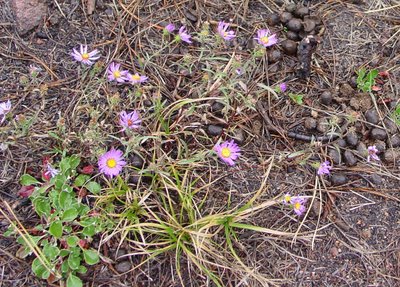Flower Fest - E for Erigeron peregrinus
Erigeron peregrinus. Sounds quite royal, doesn't it? In a way it is.
These are flowers that grow near the top of the world, almost! They are subalpine daisies, also known as subalpine fleabanes, found in montane to subalpine meadows. I saw these teeny beauties when we went camping at the Moraine Campground in Rocky Mountain National Park in the middle of September. We got snowed out on that trip and I was truly amazed to see small patches of color on the ground, despite the weather. A closer look revealed these gorgeous teeny daisies. If you click through to the larger image, you will be able to see the ice on the flower. 
Subalpine daisies are part of the Asteraceae family, the second largest family in flowering plants. Also known as the Wandering daisy, this wildflower is found mainly in the western parts of North America. 
Erigeron peregrinus blooms are between 1/16th of an inch to 2 inches in diameter. The flowers I saw were all under 1 inch. These plants can be annuals, biennials or perennials. The photo below shows how easy it is to miss seeing these flowers! Yes, that is elk poo, works as a natural fertilizer, I am sure!
I was very worried that I would not be able to find a Colorado Wildflower for Flower Fest - E. I was also worried that I may have to pick up a set of watercolor pencils and try my hand at a watercolor. But, a deep perusal of my digital images and the help of SW Colorado Wildflowers' web site, I found my entry for E! This is my entry for the letter E in the Flower Fest - the A - Z of Flowers.
This is my entry for the letter E in the Flower Fest - the A - Z of Flowers.
Flower Fest is the brainchild of Nature & Me and Sree. Every two weeks, the focus will be on a letter of the English alphabet. The current letter is E. I am submitting photographs of flowers as my entries.
Tags: Flower Fest, Erigeron peregrinus, subalpine daisy, subalpine fleabane, wandering daisy, wildflower
6 introspections:
There is something abt wildflowers and violet! Lovely... it almost looks like a daisy:)
except that the stems seem to be oh -so-delicate..arent the normal daisies hardier?
Sree, subalpine and alpine plants live in a very unforgiving environment. Their growing season is short: just about 30-40 days for alpine plants, longer for subalpine plants. The plants are generally very small but they have a strong root system. They look delicate but they are very hardy - in winter, they survive blustery winds, temperatures well below freezing, sandy/rocky soils and high UV. The subalpine plants have it a little better.
From what I am reading on the net and in books, most composite flowers in the asteraceae family are called daisies. SW Colorado Wildflowers says that erigerons are daisies. All this while, I thought a daisy was a particular type of flower but it seems to be more of a generic term for a composite flower with a well-defined center of disk flowers and usually a single whorl of ray flowers. The daisies we are used to in our homes and yards are annuals, eg the gerbera daisy, and are not very hardy. They bloom till frost and may reseed. Shasta daisies are perennials and more hardy. The gorgeous cosmos you painted is also a daisy! Check out Daisy Paradise for everything daisy!
Interesting, no?!
Wow Manisha. That flower looks so lovely. I don't think I would have noticed it while passing by (like most of other wild flowers).
I think i will be more observant abt wild flowers after this flower fest.
I love their name. Good job digging up the pic and identifying it. I give up too easily.
Shilpa, I started noticing small plant life after we went up to Pikes Peak on the Cog Railway. The guide mentioned that alpine plants grow only a couple of inches a year and that when you trample them, you could be killing decades of growth!
Gini, I never really cared about names. If it looked good, I took a picture and enjoyed it. Flower Fest became a reason to find out names, cultivars, when they bloom and how they propagate. It's been a real fun and educational experience so far!
Post a Comment